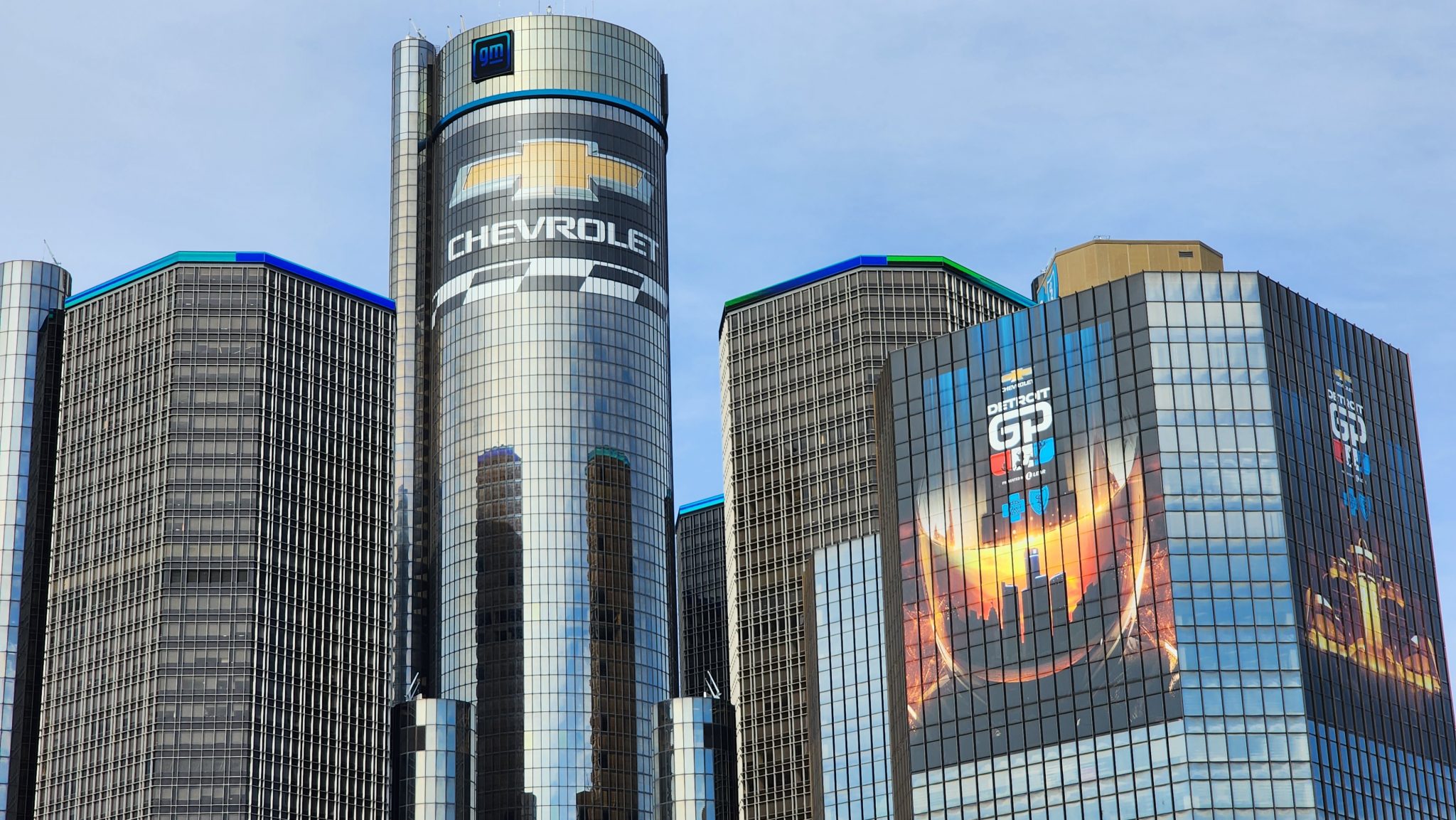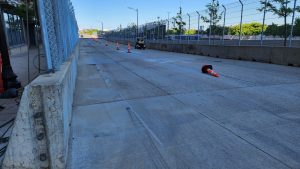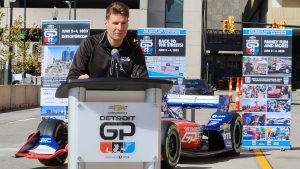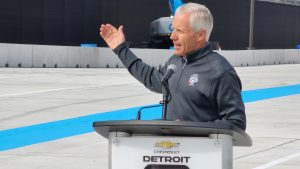Detroit Grand Prix returns to downtown streets this weekend
With a new racecourse around the Renaissance Center comes new challenges for organizers and law enforcement — and more access for fans.

The Renaissance Center stands decorated for the 2023 Detroit Grand Prix.
Coming off the 107th running of the Indianapolis 500, IndyCar makes its annual stop in the Motor City this weekend for the Detroit Grand Prix. But unlike in years passed, the event will not be held at the Raceway on Belle Isle.
Instead, for the first time since 1991, legal car racing will be taking place on downtown streets. A new temporary circuit has been setup around the Renaissance Center, running along Jefferson Avenue and the Detroit Riverfront.
Listen: What you need to know about the “new” Detroit Grand Prix.
A new venue
Many Detroiters had complained about the race on Belle Isle, with the event notoriously impacting park access for several weeks. But the motivation to move came after race organizers saw the success of a new IndyCar race that launched in downtown Nashville in 2021 — with a desire to see if what worked for that event could work here.

From there, Grand Prix chairman Bud Denker says things came together fast.
“You know (Grand Prix president) Michael Montri and I had this idea just 18 months ago to bring this race from Belle Isle to downtown Detroit.”
The move to city streets comes with one year left on the island’s contract.
Will Power won the final Detroit Grand Prix on Belle Isle and is the reigning IndyCar Series champion. Like many of the drivers, Power has mixed emotions about leaving the island raceway.
“Belle Isle was an amazing track,” says Power. “It was a real drivers track — you had to attack really hard.”
But he says Belle Isle did have some drawbacks that the new venue addresses.
“It wasn’t very accessible to people,” he continues. “I think this brings the race to the people downtown.”
New venue perks
That’s a thought that has been echoed by race organizers and city officials, like city council president Mary Sheffield.
“Going on the island was a lot more secluded — it didn’t feel inclusive,” says Sheffield. “This open space right on the streets of our city makes it feel a lot more open.”
One way the event will be more “inclusive” is that a large portion of the track around Hart Plaza will be open for free public viewing – no ticket required. Sheffield says that will offer an additional boost for businesses.
“Because people coming from the races directly over there will patronize those businesses,” she says.
Security
When the race was held on Belle Isle, there was only one way onto the island. Spectators shuttled across the McArthur Bridge and passed through the same security checkpoint.
With the race moving back downtown, there will be more ways to enter the event. And with a large section of the track open for free public viewing, anyone walking the street will have access.
“We’ve got big city problems with folks coming down.” — James White, Detroit Chief of Police
“Security is the primary concern,” says Detroit police chief James White. “We’ve got big city problems with folks coming down.”
White says the agency has talked with law enforcement in other cities that have held similar events — picking their brains on things like traffic flow and crowd management.
“The other thing that we look at is the fireworks,” says White. “We know that we can swell up to half-a-million people if the weather is good on a fireworks.”
White says he doesn’t expect as many people to attend the Grand Prix as Detroit’s annual summer fireworks show. But some of the enforcement practices from that event will apply, such as the use of undercover officers in the crowd.
First year questions
While optimism for a smooth, successful weekend is high among officials, race organizers know there will be some learning on the job. Nobody involved in the 1991 downtown race is part of the management team this time around.
For Bud Denker’s crew, this is a first-year event.
“I call it whack-a-mole,” says Denker. “There’s something that comes up every other minute that we didn’t expect. And that’s going to happen all through the race and we’ll learn from that and make it better.”
Denker has experience in that area. He was the grand prix chairman when the race re-launched on Belle Isle in 2012. That year, the grip of the race car tires tore up chunks from the road, leading to a long delay. But changes were made and nothing like that has happened since.
“I want to win the first race back here and jump in that river, and then they can get me about a mile downstream.” — Will Power, IndyCar driver

One thing that might be learned this weekend is whether a new victory tradition will be created. Over the years at Belle Isle, it became ritual that the winner of the race would leap into the water of the Scott Memorial Fountain.
It’s something driver Will Power mused during a recent press conference.
“I got to win the last race on Belle Isle,” says Power, “I got to jump in that fountain. I want to win the first race back here and jump in that river, and then they can get me about a mile downstream.”
Speaking afterwards in private, Power was a bit more hesitant on taking the plunge. If the winner on Sunday does decide to take a celebratory swim, the Detroit Grand Prix’s new victory lane is on the Riverwalk.
Quality of racing
One interesting feature of the new circuit is a six-lane-wide pit road, where cars will be stopping on the left- and right-hand sides for service during the race. It’s something Bud Denker says will make the track unique.
“They’re gonna merge in 150 feet from six-lanes to one-lane,” says Denker. “That’ll be a spectacle in itself.”

A normal pit lane is only three lanes wide, with cars stopping on one side. It will be the drivers who have to negotiate the new double-wide design — drivers like Will Power.
“I think it’s going to work no problem,” says Power. “It’s just very interesting, like, under yellow — if everyone comes in — how they’ll filter out.”
There are also questions around how many overtaking opportunities the new track presents, where the Belle Isle course offered several good places for drivers to pass other cars on any given lap.
At the new downtown track, a long straightaway down Jefferson Avenue into a tight hairpin turn is expected to create on-track action. Beyond that, Power thinks that overtaking could also happen along the pit straight going into turn one.
Trusted, accurate, up-to-date.
WDET strives to make our journalism accessible to everyone. As a public media institution, we maintain our journalistic integrity through independent support from readers like you. If you value WDET as your source of news, music and conversation, please make a gift today.

